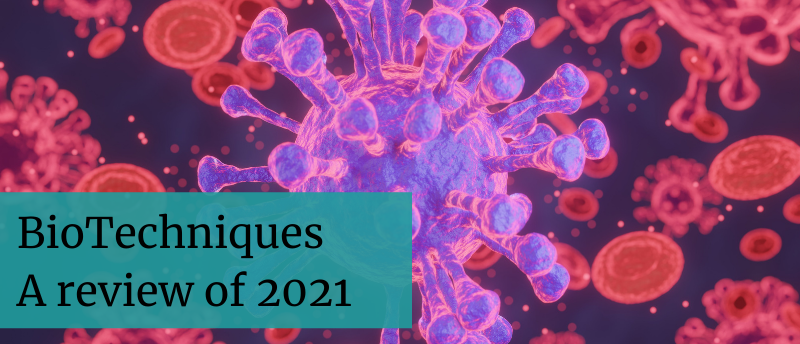2021 with BioTechniques: our top content and a review of the year

Where 2020 saw an explosion of infectious disease research to begin to understand and combat COVID-19, 2021 has seen the implementation of this research, in vaccine rollouts and surveillance programs, and the gradual return to the fore of more diverse forms of research. Likewise, BioTechniques saw the introduction of numerous new features in 2020 that have been built upon and refined in 2021, while we continue to expand our offering to members of the community.
Here, we review our most popular content and the features that have helped cover the changing research landscape throughout the year.
Top Content
Our top content throughout the year was heavily influenced by COVID-19, driving two key pieces of content into the top spots and the increased impetus on the importance of up to date and accurate diagnostics for a variety of diseases likely played a key role in the performance of our diagnostics eBook.
However, it was good to see the traditional BioTechniques content on the lighter side of science still attracting attention, with an exploration of the phenomenon of misophonia – the rage experienced by some in reaction to the sound of eating – featuring as our third most popular post. Social responsibility in science is another aspect that sits at the heart of the BioTechniques philosophy. This is clearly a cause supported by our audience, highlighted here by the inclusion of our Black History Month Twitter Chat page as one of our best performing pieces of content throughout the year.
Talking Techniques | COVID-19 diagnostics: which test should you choose?
RT-PCR, antigen and antibody testing; each has its niche and each has a flaw. But what are the key differences between each of these tests and what are the key things to consider when selecting the appropriate COVID-19 testing technique for you?
A spray a day could keep COVID away
Hands, face, space. These are the three tools available to everyday citizens to prevent the spread of COVID-19; the simple actions of washing your hands, covering your face with masks and keeping 2m space between you and others. But what if we have been missing another tool that the everyday pandemic survivor could be using to prevent infections?
 Talking Techniques | COVID-19 diagnostics: which test should you choose?
Talking Techniques | COVID-19 diagnostics: which test should you choose?
In this podcast episode, we speak to Senior Scientist in assay development Paolo Piatti to answer this question.
Hate the sound of chewing? Here’s why
A new study reveals the mechanism behind misophonia, a condition that causes exceptionally negative responses to specific sounds, providing an insight into new potential treatments.
The cause of this fury is seemingly stimulated by ‘trigger’ sounds, typically originating from facial activity – most famously the sound of chewing. Misophonia can be experienced so severely that it can affect relationships and prevent sufferers from engaging in social situations. Until recently, the mechanism for this condition was poorly understood.
2020 in review: diagnostics eBook
From PCR to cancer, crops to COVID-19, this eBook contains six of our most popular journal articles and one online article covering diagnostics.
Black representation in science – a Twitter chat #FSGForBHM21
In collaboration with Future Science Group, BioTechniques hosted a Twitter chat focusing on the themes of Black representation, identity and diversity in science in honor of the US Black History Month.
Get answers from our experts to key questions, including: What are some of the key factors limiting the representation of Black people in science? What pressures and stresses do Black people face within these spaces? What is being done to improve representation and what more can the establishment and individuals do to help?
Features
With access to conferences and in-person events severely impacted throughout the year, we had to be creative with ways to gather content and share it with you. With these factors in mind, we have refined our partnered projects and introduced a brand-new section to the website: BioTechniques Learn
LEARN
To continue our support of early-career and aspiring researchers, we launched BioTechniques LEARN to provide protocols, method guides, careers and publishing advice, all in one easy-to-access place. With a panel of engaging and inspiring mentors to support users and provide content, this section will continue to grow throughout 2022 into a resource for all researchers looking for tips and advice for their research.
 Hate the sound of chewing? Here’s why
Hate the sound of chewing? Here’s why
A research team from Newcastle University identified a neurological link that provides a clear hypothesis for the mechanism of misophonia, using fMRI to measure the response to triggers.
Partnered activities
In 2021 we hosted more webinars and panel discussions ever before, while our brand new Coffee Chat features have also emerged as a more relaxed approach to these conversations. We partnered with key opinion leaders and field-leading vendors – such as 10x Genomics, Zymo Research, Thermo Fisher Scientific, Sartorius and Tecan – to publish quarterly Spotlight features and monthly In Focus features, ensuring members still have avenues to gain information on and explore the most innovative technologies and rapidly expanding fields.
Staff
2021 has also seen a great change in people who keep BioTechniques running. After almost 4 years as the face of BioTechniques incumbent Editor-in-Chief Francesca Lake left in July for pastures new and was replaced Michelle Itano (University of North Carolina, NC, USA) who brings a wealth of experience and vision from work as the Director of the UNC Microscopy Core. Furthermore, as the year draws to a close, Senior Editor Abigail Sawyer has left for a new challenge at the Centre for Process Innovation in Glasgow. Exciting new additions to the site include Editor Annie Coulson and Assistant Editor Aisha Al-Janabi. We would like to thank both Francesca and Abigail for their dedicated service to BioTechniques over the years and are thrilled to see how the site and journal will develop over throughout 2022!





